59 Cell Phone/Smartphone Addiction Statistics (2023)

-80.avif)
Looking For Cell Phone Addiction Statistics?
Smartphones have become an integral part of our lives. We depend on them for communication, entertainment, and information. However, studies have shown that excessive use of cell phones can lead to addiction. In this roundup of cell phone addiction statistics, we will explore the statistics on cell phone addiction that show how widespread this problem has become.
Top 10 Smartphone Addiction Statistics:
- According to a study by the Pew Research Center, 81% of Americans own a smartphone.
- The same study found that 46% of Americans say they can’t live without their smartphones.
- A survey by Common Sense Media found that 50% of teens feel addicted to their mobile devices.
- A study by the University of Derby found that students who use their phones frequently during class had lower exam scores.
- The same study found that 13% of students admitted to using their phones during exams.
- A study by the American Psychological Association found that 67% of people check their phones even when they don’t hear a notification.
- A survey by Deloitte found that Americans check their phones on average 52 times a day.
- A study by the University of Washington found that one-third of pedestrians in high-risk areas cross streets while distracted by their phones.
- The same study found that distracted walking injuries have more than doubled since 2004.
- A survey by the Center on Media and Child Health found that 75% of children aged 8 and younger have their own mobile device.
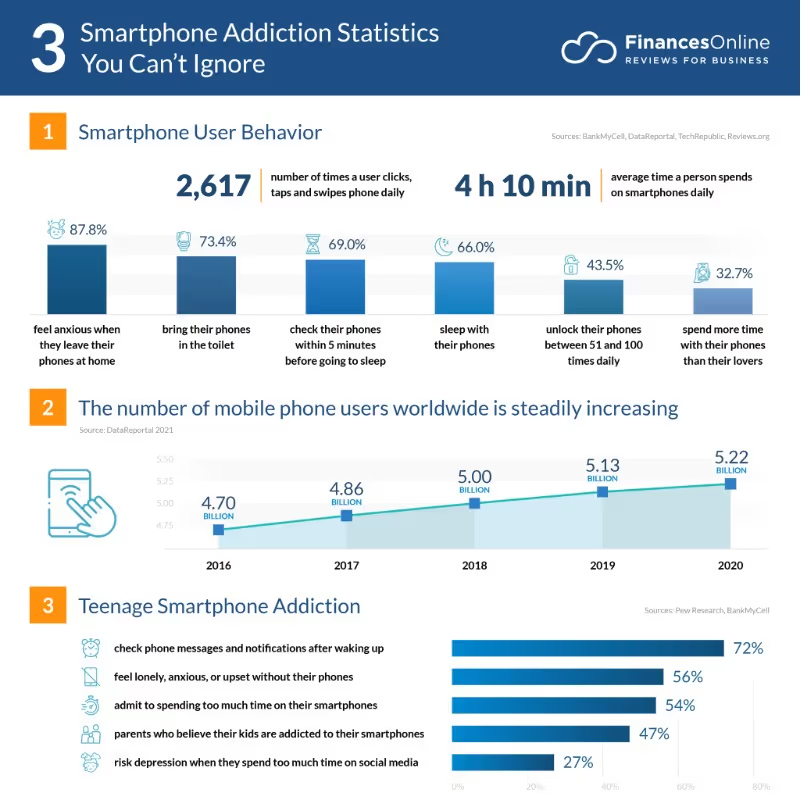
Cell Phone Addiction Statistics
Americans' cellphone usage and habits have drastically changed in recent years. A study by the Pew Research Center found that 96% of Americans own a cellphone, with 81% owning a smartphone. Furthermore, the survey found that 15% of Americans are "smartphone-only" internet users, meaning they do not have traditional home broadband services and rely solely on their smartphones for internet access.
The same study also revealed some interesting statistics about how Americans use their cellphones. For instance, 92% of smartphone owners use their phones to send text messages, while 84% use it to browse the internet. In addition, social media apps are among the most frequently used apps on smartphones with Facebook being the most popular app overall.
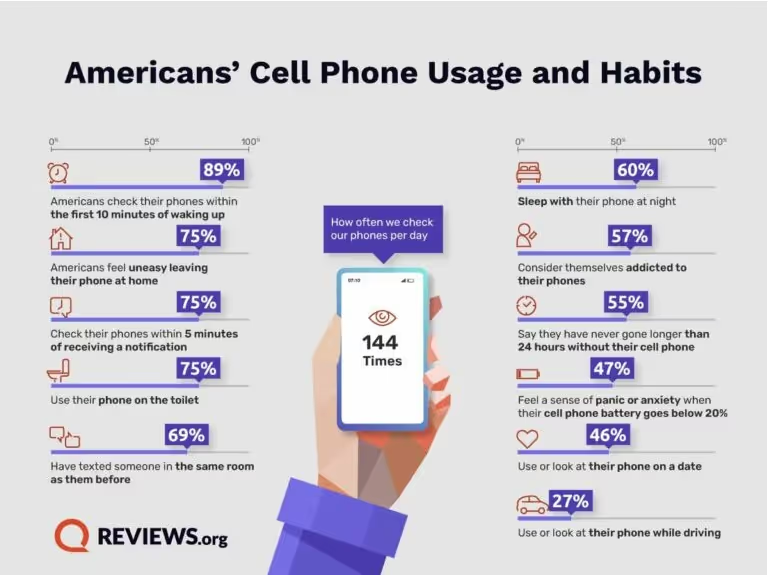
Another study by Deloitte found that around one-third of American adults check their phones in the middle of the night. This habit can significantly affect sleep quality as exposure to blue light emitted by electronic devices can suppress melatonin secretion and disrupt circadian rhythm.
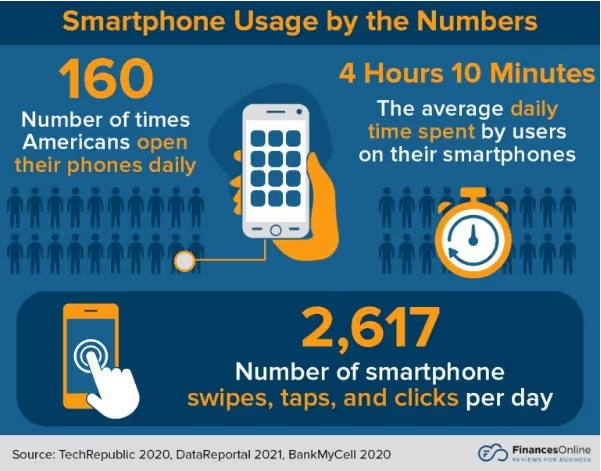
These statistics show how deeply ingrained cellphones have become in our daily lives and highlight potential issues such as addiction and sleep deprivation that may arise due to excessive usage.
Smartphone Usage by Generation
Cell phones have become ubiquitous in our daily lives regardless of age. However, the way different generations use their phones varies significantly. A study by Pew Research Center shows that 96% of millennials own a smartphone compared to 79% of baby boomers. Additionally, younger generations tend to spend more time on social media platforms such as Instagram, Snapchat, and TikTok compared to older generations who prefer Facebook.
Research indicates that there are notable differences in how Americans use their cell phones, depending on their generation. For instance, members of Gen Z tend to check their phones promptly after receiving notifications, and are more prone to anxiety when separated from their device.
However, not all age groups exhibit the same behavior. While some Millennials may appear attached to their phones, many feel comfortable delaying notifications until later. Nevertheless, both Gen Z and Millennials remain the most likely groups to engage in risky behavior for the sake of their phone.

- According to a recent study, when it comes to checking their phones after receiving a notification, Gen Z is the generation that is most inclined to do so within 5 minutes.
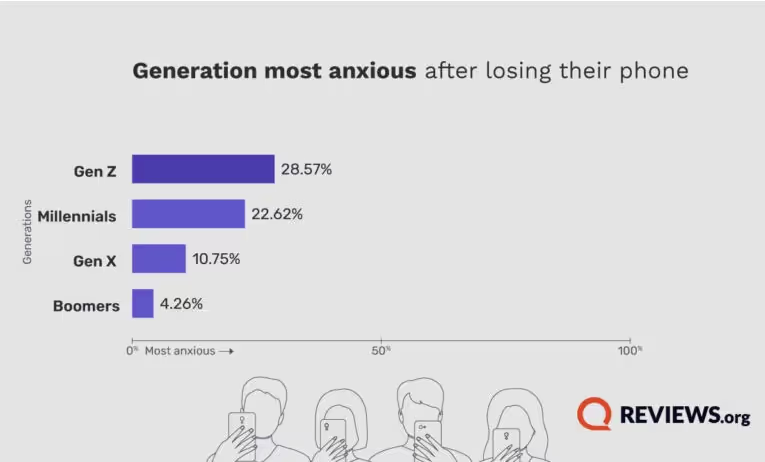
- A recent study found that Gen Z is the generation most likely to experience anxiety after losing their phone.
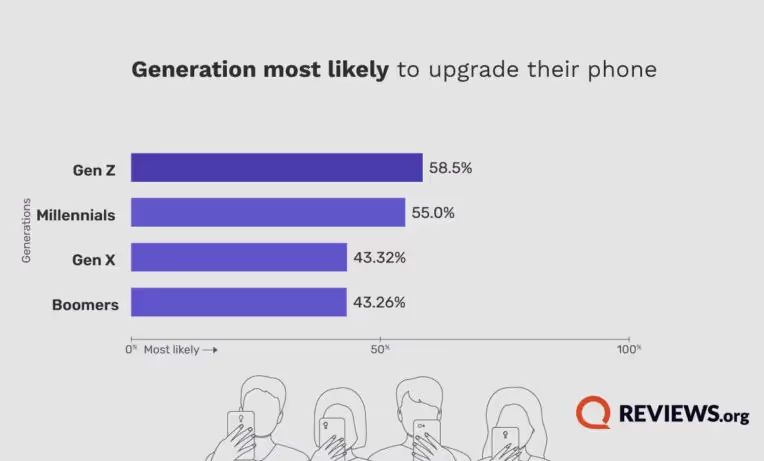
- According to recent data, Gen Zers are the generation that upgrades their phones the most, with 58.5% of them reporting having upgraded their device in the past year. In contrast, Boomers and Gen X are the generations that upgrade the least, with only 43% of them having done so in the same period.
These statistics indicate that while cell phone usage is widespread across all age groups, the way different generations use their phones differs significantly. Understanding these differences can help us design better products and services that cater to different age groups' needs and preferences.
Smartphone Usage in School
The use of smartphones in schools has become a controversial topic. While some educators believe that allowing students access to their phones can increase engagement and improve learning outcomes, others fear that excessive phone usage can be distracting and detrimental to academic performance.
A study by the University of Nebraska-Lincoln surveyed 675 college students and found that 99% of them owned a smartphone. Additionally, the study revealed that 70% of students reported using their phones for non-class purposes during class time, with social media being the most common distraction.
Another study conducted by researchers at Rutgers University found that students who used their phones for non-academic purposes during class scored lower on exams than those who did not. The study also found that even having a phone visible on a student's desk can be enough of a distraction to negatively impact learning.
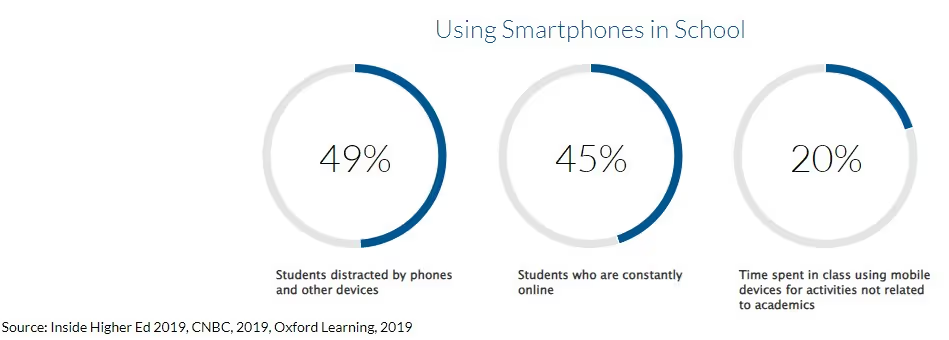
Despite these findings, many schools still struggle to regulate cell phone usage in classrooms. A survey by Common Sense Media found that only 13% of teachers reported enforcing strict no-phone policies in their classrooms.
These statistics suggest that while smartphones have become ubiquitous in schools, they may also pose a significant distraction to students' learning experience. As such, it is important for educators and policymakers to consider implementing effective strategies to regulate phone usage in classrooms and promote more productive learning environments.
Teen Smartphone Addiction and Cell Phone Usage Statistics
The addiction to cell phones is particularly acute among teenagers. According to a study by the Pew Research Center, 95% of US teens have access to a smartphone, and 45% say they are online almost constantly. This constant connectivity can have negative effects on their mental health, academic performance, and social skills.
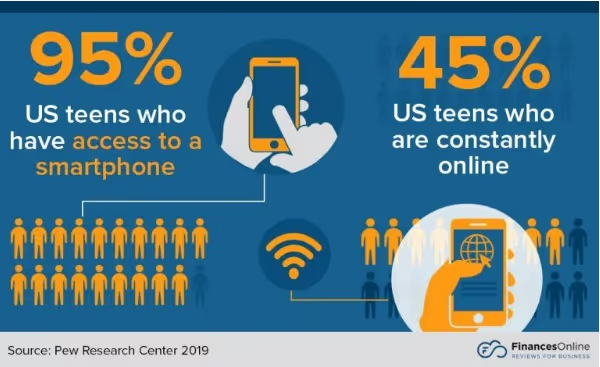
A survey by Common Sense Media found that 72% of teens feel the need to respond immediately to messages, notifications, and alerts from their phones. This behavior can lead to distraction and reduced productivity when studying or completing homework.
Moreover, excessive use of cell phones has been linked to sleep deprivation among teenagers. A study by the National Sleep Foundation found that 87% of high school students do not get enough sleep during the week because they are using their phones at night.
In addition, social media platforms such as Instagram, Snapchat, and TikTok have become popular among teenagers who spend hours scrolling through feeds and posting updates. A study by the Royal Society for Public Health found that these platforms can contribute to anxiety, depression, cyberbullying, and body image issues among young people.
Smartphone Usage at Work
Smartphones have become an essential tool for many employees, allowing them to stay connected and productive while on the go. According to a study by CareerBuilder, 82% of workers keep their smartphones within eye contact while at work, and 55% of them check their phones at least once every hour.
Another study by the Pew Research Center found that 77% of Americans own a smartphone, with 45% of them using their phones to access the internet for work-related purposes. Moreover, the same study revealed that younger workers are more likely to use their smartphones for work-related tasks than older workers.
A survey conducted by Business Insider found that 64% of employees use their smartphones to check emails outside of normal working hours. While this behavior may seem harmless, it can lead to burnout and negatively impact employees' mental health.
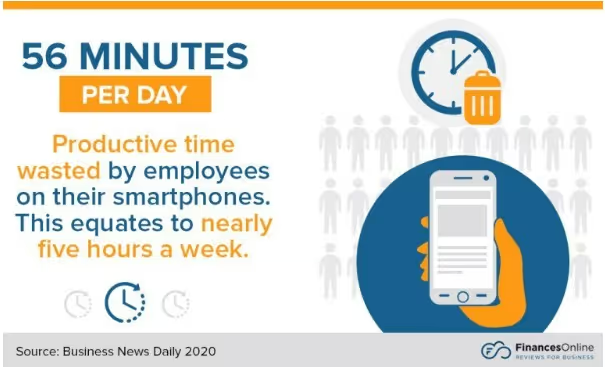
These statistics highlight the need for employers to establish clear guidelines on smartphone usage in the workplace. While smartphones can improve productivity and communication, excessive usage can be distracting and detrimental to employee well-being.
Adult Smartphone Addiction and Cell Phone Usage Statistics
While teenagers are often associated with excessive cell phone use, adults are not immune to addiction. In fact, according to a study by the Pew Research Center, 74% of American adults own a smartphone.
Furthermore, a survey by the American Psychological Association found that 44% of adults feel anxious when they don't have their phones with them. This anxiety is often referred to as "nomophobia," or the fear of being without one's phone.
Another study by Deloitte found that 86% of smartphone owners check their devices at least once a day, and nearly one-third check their phones within five minutes of waking up in the morning.
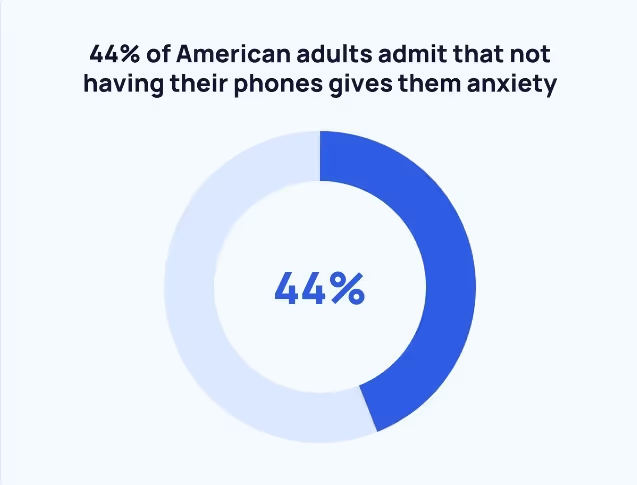
Moreover, cell phone addiction can have negative effects on personal relationships. A study published in Computers in Human Behavior found that excessive cell phone use was associated with lower relationship satisfaction and higher levels of depression and anxiety.
It is clear that addiction to smartphones is not limited to teenagers. Adults must also be aware of the potential negative consequences of excessive cell phone use and take steps to establish healthy habits.
How Much Do We Use Our Smartphones?
Smartphones have become an indispensable part of modern life. In fact, according to a study by RescueTime, the average American spends roughly 3 hours and 15 minutes on their phone per day. This amounts to nearly a quarter of the time we spend awake.
But it's not just the amount of time we spend on our phones that's concerning. Research shows that smartphone users engage with their devices frequently throughout the day. For instance:
- A Deloitte survey found that Americans check their phones an average of 52 times a day.
- Another study by dscout revealed that heavy smartphone users tap, swipe, and click their phones over 2,600 times per day on average.
- The same study also found that people in the top 10% of phone use interact with their device an astonishing 5,400 times per day.
These statistics paint a picture of a society that is increasingly reliant on smartphones. While these devices offer many benefits, they can also be addictive and lead to negative consequences such as decreased productivity, poor sleep quality, and strained relationships.
Smartphone Addiction And Relationships
Smartphone use has become ubiquitous in modern society, but it can also have a detrimental impact on personal relationships. Here are some statistics that illustrate this point:
- A study by the University of Arizona found that higher levels of smartphone use were associated with greater relationship conflict and lower relationship quality. Furthermore, the study found that people who reported being addicted to their phones were more likely to experience relationship problems.
- Another survey by Pew Research Center revealed that 25% of married or partnered adults felt that their significant other was distracted by their phone when they were together. This can lead to feelings of neglect and disconnection in the relationship.
- Additionally, 18% of respondents in the same survey said they had argued with their partner about excessive phone use. These arguments can erode trust and intimacy between partners.
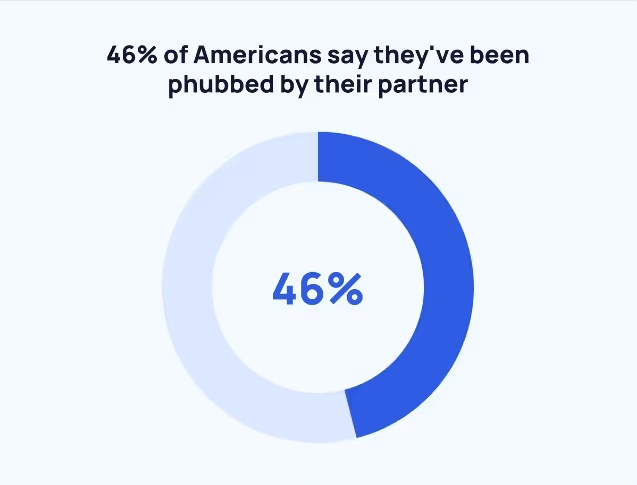
These statistics underscore the importance of establishing healthy habits when it comes to smartphone use, particularly in the context of romantic relationships. By being present and engaged with our partners instead of constantly checking our phones, we can strengthen our relationships and improve overall well-being. It's important to set boundaries and communicate openly with our partners about our phone use to ensure that our devices don't come between us.
How Bad is Smartphone Addiction?
Smartphone addiction is a growing concern in today's society. According to a survey by Common Sense Media, 50% of teens feel addicted to their cell phones, and 27% of parents report feeling addicted to their devices as well.
Moreover, a study by the University of California found that excessive smartphone use can lead to increased anxiety, depression, and stress. The same study also revealed that people who spend more time on their phones tend to have poorer sleep quality.
In addition, research has shown that smartphone addiction can have negative effects on productivity and academic performance. A study by the University of Texas found that students who used their phones during class scored lower on exams than those who did not.
Furthermore, excessive cell phone use can lead to social isolation and reduced face-to-face communication skills. A survey by the American Psychological Association found that 43% of adults feel ignored or unimportant when their partner uses their phone in their presence.
The Dangers of Heavy Smartphone Use
The dangers of heavy smartphone use are well-documented. Research has shown that excessive phone usage can have negative effects on our mental and physical health.
For instance, a study by the University of Arizona found that people who spend more time on their phones tend to experience higher levels of anxiety and depression. Another study by the University of California revealed that heavy smartphone use can lead to increased stress and decreased happiness.
Moreover, excessive phone usage has been linked to physical ailments such as eye strain, neck pain, and headaches. A survey by the Vision Council found that 70% of US adults reported experiencing digital eye strain due to prolonged screen time.
These statistics highlight the need for individuals to be mindful of their smartphone usage and take steps to establish healthy habits. This might include setting limits on phone usage, taking regular breaks from screens, or engaging in other activities that promote well-being.
It's important for us as a society to recognize the potential dangers of heavy smartphone use and work towards creating a healthier relationship with these devices. By being intentional about our phone usage, we can improve our overall health and well-being.
Conclusion
These addiction to cell phone statistics show that this is a growing problem that affects people of all ages. It is important to be aware of the potential dangers of excessive cell phone use and take steps to limit our usage. This can include turning off notifications, setting aside specific times to use our phones, and avoiding using our phones while driving or walking in high-risk areas. By being mindful of our phone usage, we can reduce the risk of addiction and its negative effects on our lives.
If you or a loved one are experiencing an addiction of any kind, reaching out for help can be a vital step toward healing and recovery. If you are seeking an addiction treatment center in Columbus, Ohio for help with a drug or alcohol addiction, contact the team at Dove Recovery today.
